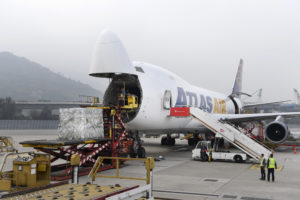 Each year, Atlas Air operates as many as 68,000 flights to 314 destinations in 74 countries connecting producers to consumers and carrying everything from military equipment to pharmaceuticals and fresh fruit and flowers.
Each year, Atlas Air operates as many as 68,000 flights to 314 destinations in 74 countries connecting producers to consumers and carrying everything from military equipment to pharmaceuticals and fresh fruit and flowers.
Before any of those flights take off, the Atlas team undertakes a rigorous set of procedures to ensure the safety of the flight, its Crew and cargo.
Intense preparation and planning go into every flight, with a load plan created to meet the needs of every type of specialized cargo.
Typically, cargo is loaded onto pallets for transport. But pallets aren’t suited for all types of cargo. Cars and heavy mining equipment, for example, require extra planning.
As a general cargo carrier, Atlas Air specializes in transporting these types of out-of-the-ordinary cargo. Because Atlas operates more “pure freighters” than any other carrier, it is able to move special loads to locations throughout the world. These pure freighters have extra-large doors, including a nose door.
“If you look at a 747 cargo, the nose will actually open up, and you can load a really long pipe, for example,” said Richard Rolland, Senior Vice President, Safety and Regulatory Compliance at Atlas Air.
Atlas’s special loads department builds a load plan for special cargo within 48 hours of receiving a transport request. The plan uses the cargo’s weight, size and shape to determine how it should be stowed while taking into account the aircraft’s balance and capacity requirements.
The plan also factors in conditions necessary for the cargo load while onboard. Many types of cargo require carefully maintained temperature control – flowers, pharmaceuticals and produce, for example. Atlas’s load plans include consideration of the amount of time that sensitive cargo must spend outside. The Crew operating the flight also are aware when the load being carried is perishable.
“Any cargo that is temperature sensitive needs to move quickly. That’s why air is usually the transport method chosen,” Richard explained. “The considerations start at the loading of the aircraft. (The cargo) comes from a temperature-controlled warehouse onto a loader and onto the airplane. Loading is done as quickly as possible.”
Once the load is in place on the aircraft, Crew members are given instructions for setting temperatures for the flight deck and cargo deck through the aircrafts’ Environmental Control Systems in the cockpit.
“Our teams do a great job of working together to make sure the cargo we fly around the world arrives at its destination safely and as our customers expect. That could be sensitive medical equipment or 8,000 pounds of strawberries,” said Bryan Brown, Senior Director of Safety for Atlas’s Southern Air.